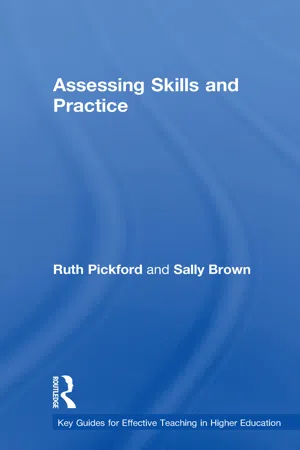
This is a test
- 160 pages
- English
- ePUB (mobile friendly)
- Available on iOS & Android
eBook - ePub
Assessing Skills and Practice
Book details
Book preview
Table of contents
Citations
About This Book
Assessing Skills and Practice outlines how to ensure fair, consistent and reliable assessment of practical activities. With a particular focus on formative feedback and its role in helping students to understand what is required of them, this guide is packed with advice, examples and case studies covering the key areas, including:
-
- assessing across the arts, humanities and sciences – from labwork and clinical practice to dance
- assessing oral work
- using feedback
- ensuring inclusive and fair assessment.
This volume is an ideal introduction for new or part-time lecturers and will also be valued by experienced teachers who are new to this area of assessment or who want to improve their current practice.
Frequently asked questions
At the moment all of our mobile-responsive ePub books are available to download via the app. Most of our PDFs are also available to download and we're working on making the final remaining ones downloadable now. Learn more here.
Both plans give you full access to the library and all of Perlego’s features. The only differences are the price and subscription period: With the annual plan you’ll save around 30% compared to 12 months on the monthly plan.
We are an online textbook subscription service, where you can get access to an entire online library for less than the price of a single book per month. With over 1 million books across 1000+ topics, we’ve got you covered! Learn more here.
Look out for the read-aloud symbol on your next book to see if you can listen to it. The read-aloud tool reads text aloud for you, highlighting the text as it is being read. You can pause it, speed it up and slow it down. Learn more here.
Yes, you can access Assessing Skills and Practice by Sally Brown, Ruth Pickford in PDF and/or ePUB format, as well as other popular books in Education & Education General. We have over one million books available in our catalogue for you to explore.
Information
Chapter 1
The importance of good practical assessment design
Assessment methods and requirements probably have a greater influence on how and what students learn than any other single factor. This influence may well be of greater importance than the impact of teaching materials.
(Boud 1988)
As Boud argues: if you get the assessment right, you are likely to direct students’ activities appropriately. Students gain cues about what you value from the assignments/tasks you set and will direct their out-of-class learning activities accordingly. If we focus the tasks we set them on recall and memorisation, that’s what they’ll do! If, however, we want to encourage them to take a deep rather than a surface approach to the development of practical skills, we need to design practical assignments intelligently. We need to think not just about the assessment criteria but also about weighting, timing, agency and ‘fitness for purpose’, with imaginative consideration of methods and approaches that can challenge students, be inclusive and suit the topic, context, cohort and level. Practical assessments should link clearly to the most sensible evidence of practical skill our students could produce to demonstrate their achievement of the intended outcome. Essential to all forms of assessment is clarity about criteria, and this is particularly the case when the assessor is considering the extent to which practical skills have been satisfactorily demonstrated.
DESIGNING FIT-FOR-PURPOSE PRACTICAL ASSESSMENTS
Authentic practical assessment which genuinely assesses what it sets out to assess needs to use ‘fit-for-purpose’ assessment approaches. When designing any practical assessment instrument, process or strategy we should be seeking answers to a series of questions that can help to make the design of assignments systematic, coherent and aligned with our intentions (Box 1.1).
Box 1.1
FIT-FOR-PURPOSE PRACTICAL ASSESSMENT QUESTIONS
Why are we assessing?













What is it we are assessing?






How are we assessing?





Who is best placed...
Table of contents
- Key Guides for Effective Teaching in Higher Education Series
- Contents
- Figures
- Series preface
- Acknowledgements
- Introduction
- Chapter 1 The importance of good practical assessment design
- Chapter 2 Assessing practical skills
- Chapter 3 Ensuring equivalence of experience for disabled students
- Chapter 4 Assessing diverse students fairly
- Chapter 5 Fostering independent learning
- Chapter 6 Assessing presentations and other oral work
- Chapter 7 Assessing practical skills in laboratories
- Chapter 8 Assessing the production of artefacts in the studio and workshop
- Chapter 9 Assessing live performance
- Chapter 10 Assessing process
- Chapter 11 Using other stakeholders to assess student achievement
- Chapter 12 Assessing skills and practice
- Bibliography and further reading
- Index